MAZDA MODEL 3 HATCHBACK 2007 Owner's Manual (in English)
Manufacturer: MAZDA, Model Year: 2007, Model line: MODEL 3 HATCHBACK, Model: MAZDA MODEL 3 HATCHBACK 2007Pages: 402, PDF Size: 5.66 MB
Page 301 of 402
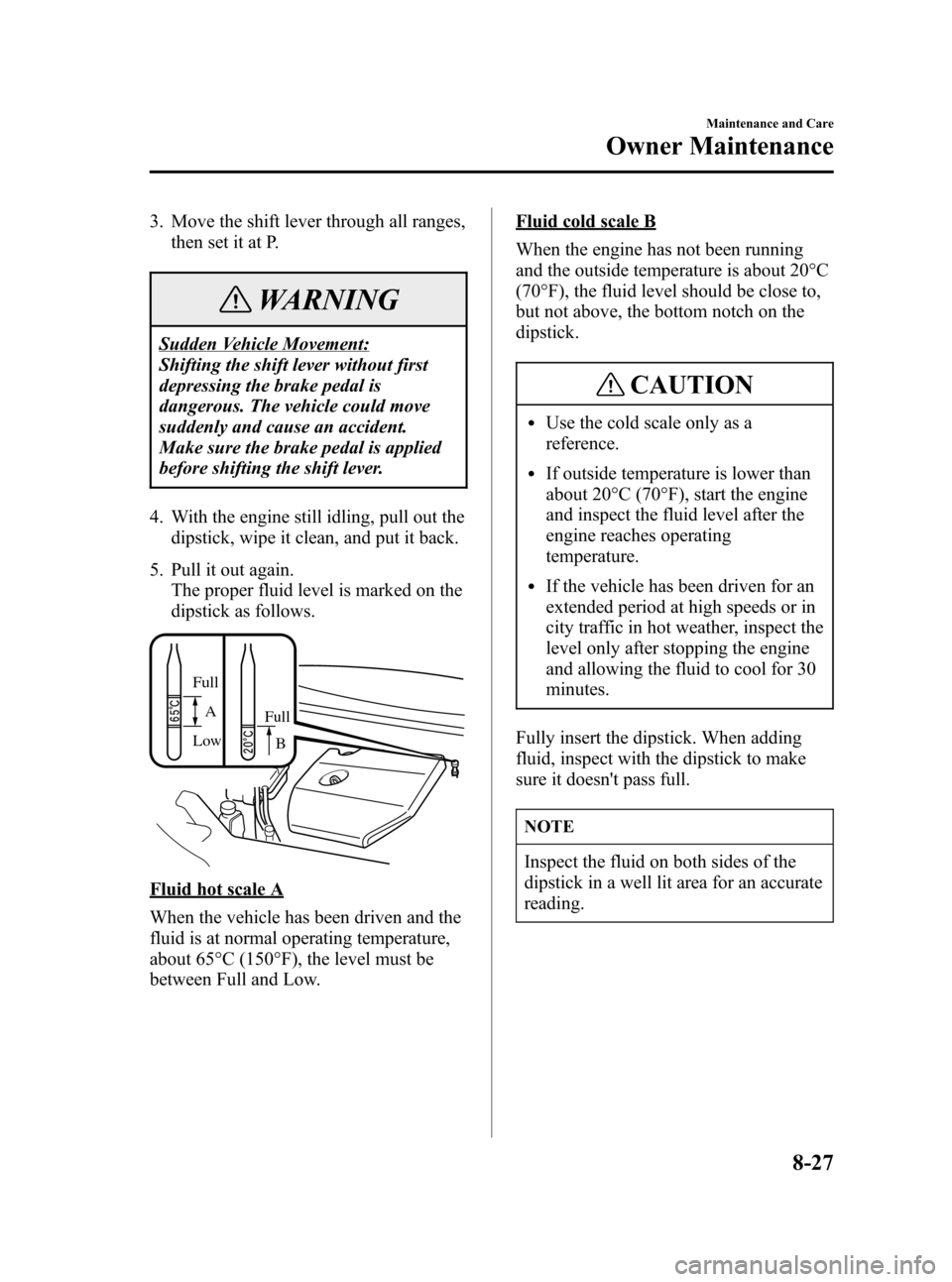
Black plate (301,1)
3. Move the shift lever through all ranges,
then set it at P.
WARNING
Sudden Vehicle Movement:
Shifting the shift lever without first
depressing the brake pedal is
dangerous. The vehicle could move
suddenly and cause an accident.
Make sure the brake pedal is applied
before shifting the shift lever.
4. With the engine still idling, pull out the
dipstick, wipe it clean, and put it back.
5. Pull it out again.
The proper fluid level is marked on the
dipstick as follows.
A Full
Low
B Full
Fluid hot scale A
When the vehicle has been driven and the
fluid is at normal operating temperature,
about 65°C (150°F), the level must be
between Full and Low.
Fluid cold scale B
When the engine has not been running
and the outside temperature is about 20°C
(70°F), the fluid level should be close to,
but not above, the bottom notch on the
dipstick.
CAUTION
lUse the cold scale only as a
reference.
lIf outside temperature is lower than
about 20°C (70°F), start the engine
and inspect the fluid level after the
engine reaches operating
temperature.
lIf the vehicle has been driven for an
extended period at high speeds or in
city traffic in hot weather, inspect the
level only after stopping the engine
and allowing the fluid to cool for 30
minutes.
Fully insert the dipstick. When adding
fluid, inspect with the dipstick to make
sure it doesn't pass full.
NOTE
Inspect the fluid on both sides of the
dipstick in a well lit area for an accurate
reading.
Maintenance and Care
Owner Maintenance
8-27
Mazda3_8V66-EA-06F_Edition3 Page301
Wednesday, August 23 2006 11:21 AM
Form No.8V66-EA-06F
Page 302 of 402
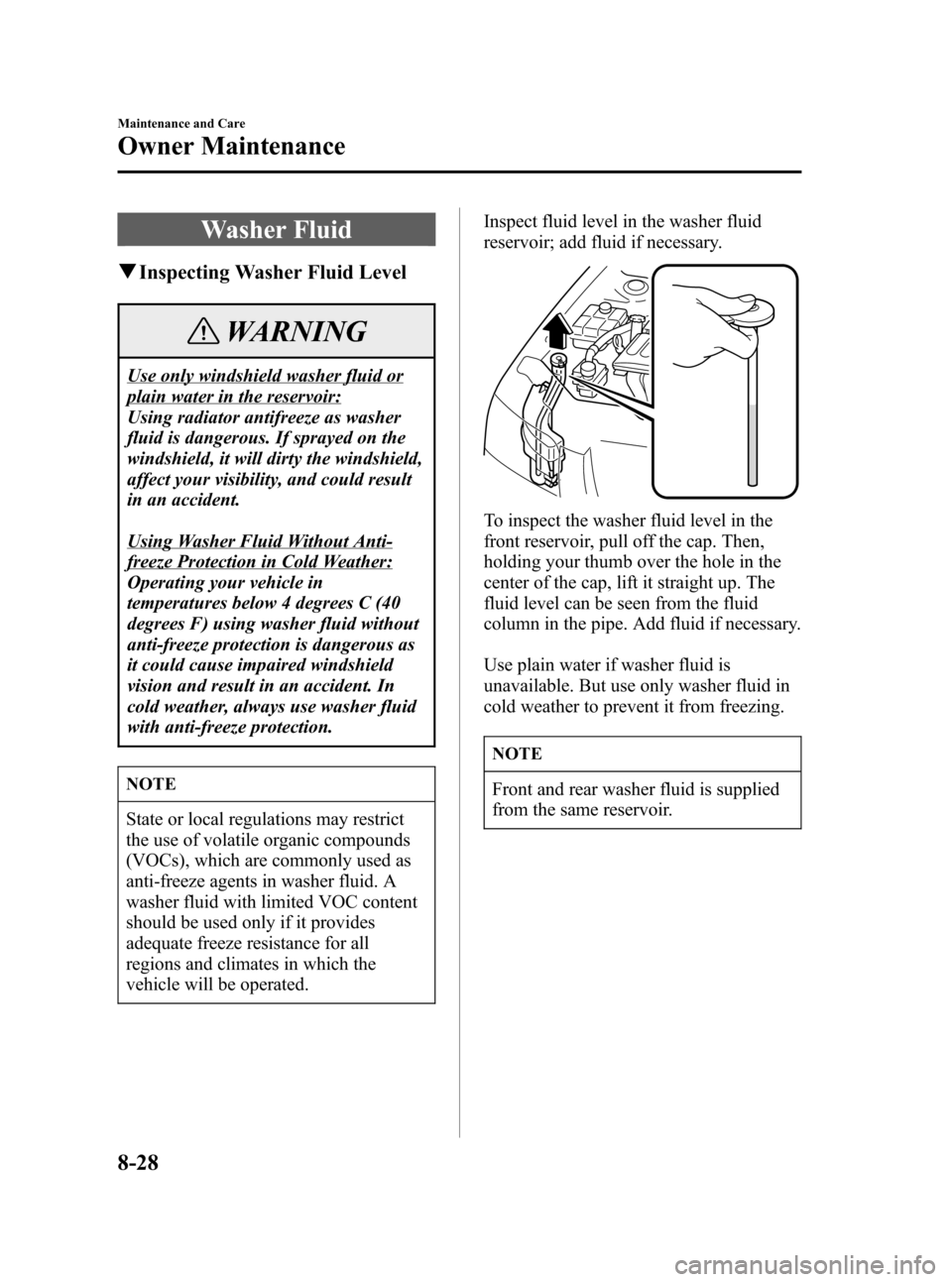
Black plate (302,1)
Washer Fluid
qInspecting Washer Fluid Level
WARNING
Use only windshield washer fluid or
plain water in the reservoir:
Using radiator antifreeze as washer
fluid is dangerous. If sprayed on the
windshield, it will dirty the windshield,
affect your visibility, and could result
in an accident.
Using Washer Fluid Without Anti-
freeze Protection in Cold Weather:
Operating your vehicle in
temperatures below 4 degrees C (40
degrees F) using washer fluid without
anti-freeze protection is dangerous as
it could cause impaired windshield
vision and result in an accident. In
cold weather, always use washer fluid
with anti-freeze protection.
NOTE
State or local regulations may restrict
the use of volatile organic compounds
(VOCs), which are commonly used as
anti-freeze agents in washer fluid. A
washer fluid with limited VOC content
should be used only if it provides
adequate freeze resistance for all
regions and climates in which the
vehicle will be operated.Inspect fluid level in the washer fluid
reservoir; add fluid if necessary.
To inspect the washer fluid level in the
front reservoir, pull off the cap. Then,
holding your thumb over the hole in the
center of the cap, lift it straight up. The
fluid level can be seen from the fluid
column in the pipe. Add fluid if necessary.
Use plain water if washer fluid is
unavailable. But use only washer fluid in
cold weather to prevent it from freezing.
NOTE
Front and rear washer fluid is supplied
from the same reservoir.
8-28
Maintenance and Care
Owner Maintenance
Mazda3_8V66-EA-06F_Edition3 Page302
Wednesday, August 23 2006 11:21 AM
Form No.8V66-EA-06F
Page 303 of 402
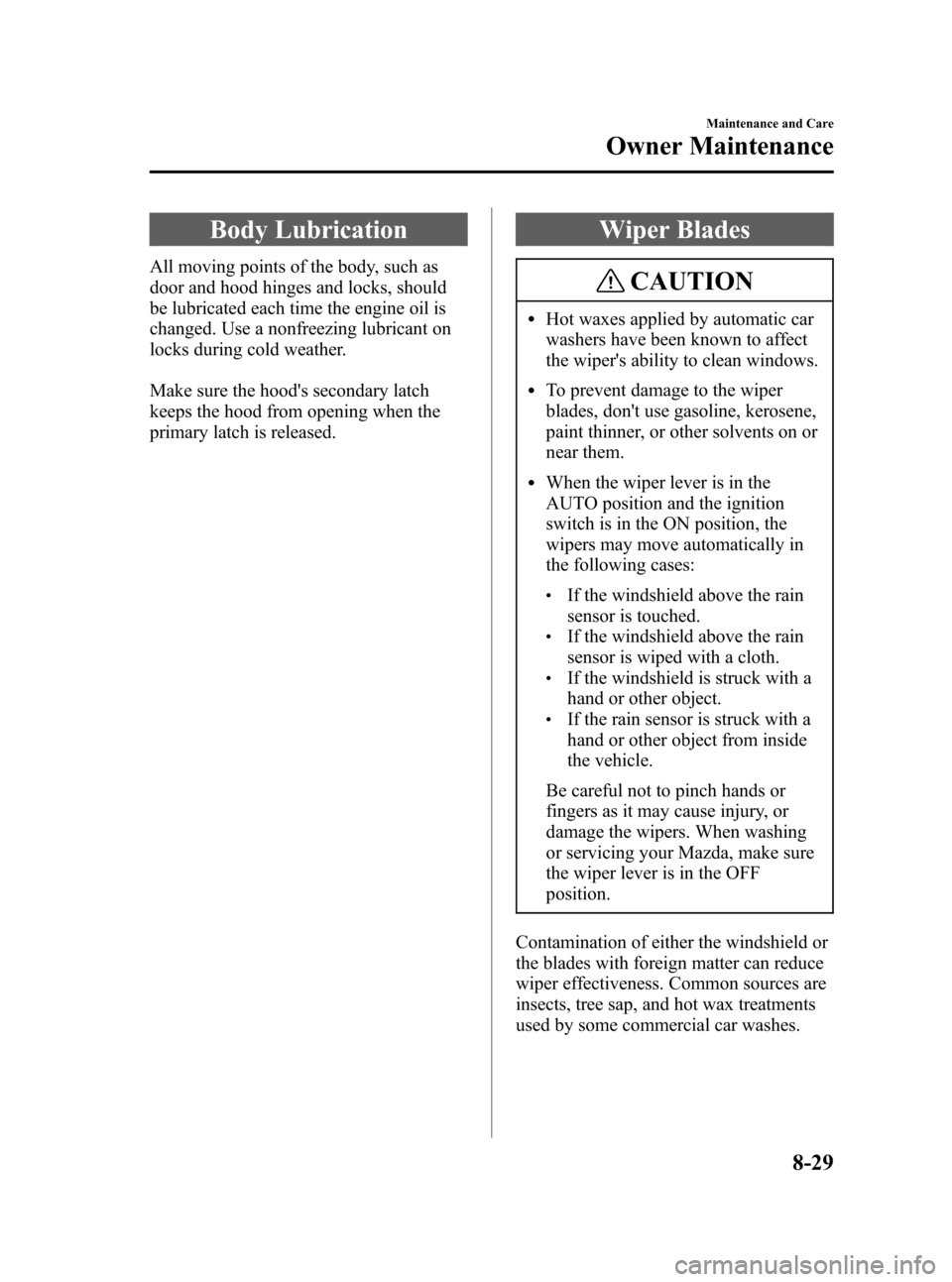
Black plate (303,1)
Body Lubrication
All moving points of the body, such as
door and hood hinges and locks, should
be lubricated each time the engine oil is
changed. Use a nonfreezing lubricant on
locks during cold weather.
Make sure the hood's secondary latch
keeps the hood from opening when the
primary latch is released.
Wiper Blades
CAUTION
lHot waxes applied by automatic car
washers have been known to affect
the wiper's ability to clean windows.
lTo prevent damage to the wiper
blades, don't use gasoline, kerosene,
paint thinner, or other solvents on or
near them.
lWhen the wiper lever is in the
AUTO position and the ignition
switch is in the ON position, the
wipers may move automatically in
the following cases:
lIf the windshield above the rain
sensor is touched.
lIf the windshield above the rain
sensor is wiped with a cloth.
lIf the windshield is struck with a
hand or other object.
lIf the rain sensor is struck with a
hand or other object from inside
the vehicle.
Be careful not to pinch hands or
fingers as it may cause injury, or
damage the wipers. When washing
or servicing your Mazda, make sure
the wiper lever is in the OFF
position.
Contamination of either the windshield or
the blades with foreign matter can reduce
wiper effectiveness. Common sources are
insects, tree sap, and hot wax treatments
used by some commercial car washes.
Maintenance and Care
Owner Maintenance
8-29
Mazda3_8V66-EA-06F_Edition3 Page303
Wednesday, August 23 2006 11:21 AM
Form No.8V66-EA-06F
Page 304 of 402
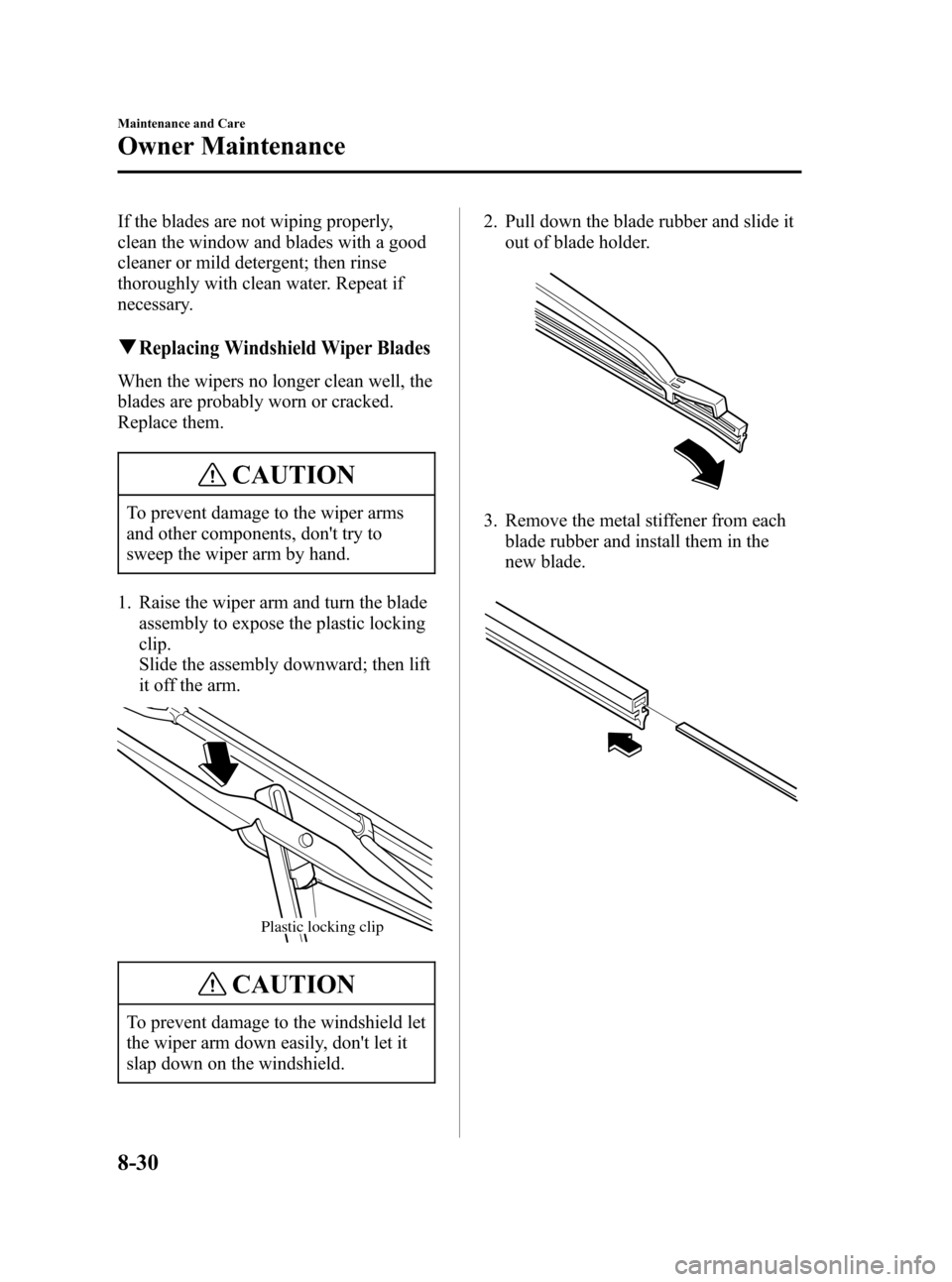
Black plate (304,1)
If the blades are not wiping properly,
clean the window and blades with a good
cleaner or mild detergent; then rinse
thoroughly with clean water. Repeat if
necessary.
qReplacing Windshield Wiper Blades
When the wipers no longer clean well, the
blades are probably worn or cracked.
Replace them.
CAUTION
To prevent damage to the wiper arms
and other components, don't try to
sweep the wiper arm by hand.
1. Raise the wiper arm and turn the blade
assembly to expose the plastic locking
clip.
Slide the assembly downward; then lift
it off the arm.
Plastic locking clip
CAUTION
To prevent damage to the windshield let
the wiper arm down easily, don't let it
slap down on the windshield.2. Pull down the blade rubber and slide it
out of blade holder.
3. Remove the metal stiffener from each
blade rubber and install them in the
new blade.
8-30
Maintenance and Care
Owner Maintenance
Mazda3_8V66-EA-06F_Edition3 Page304
Wednesday, August 23 2006 11:21 AM
Form No.8V66-EA-06F
Page 305 of 402
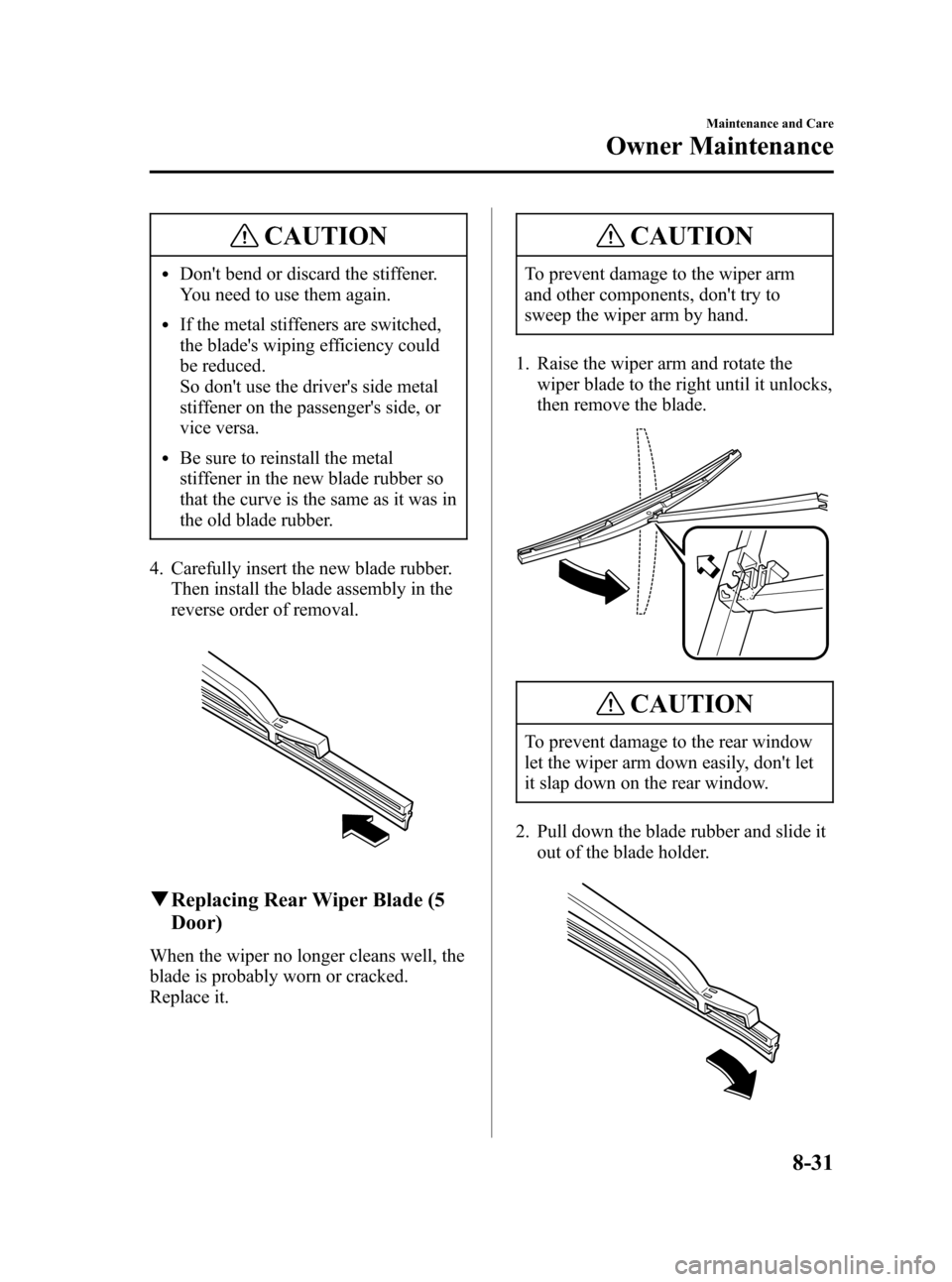
Black plate (305,1)
CAUTION
lDon't bend or discard the stiffener.
You need to use them again.
lIf the metal stiffeners are switched,
the blade's wiping efficiency could
be reduced.
So don't use the driver's side metal
stiffener on the passenger's side, or
vice versa.
lBe sure to reinstall the metal
stiffener in the new blade rubber so
that the curve is the same as it was in
the old blade rubber.
4. Carefully insert the new blade rubber.
Then install the blade assembly in the
reverse order of removal.
qReplacing Rear Wiper Blade (5
Door)
When the wiper no longer cleans well, the
blade is probably worn or cracked.
Replace it.
CAUTION
To prevent damage to the wiper arm
and other components, don't try to
sweep the wiper arm by hand.
1. Raise the wiper arm and rotate the
wiper blade to the right until it unlocks,
then remove the blade.
CAUTION
To prevent damage to the rear window
let the wiper arm down easily, don't let
it slap down on the rear window.
2. Pull down the blade rubber and slide it
out of the blade holder.
Maintenance and Care
Owner Maintenance
8-31
Mazda3_8V66-EA-06F_Edition3 Page305
Wednesday, August 23 2006 11:21 AM
Form No.8V66-EA-06F
Page 306 of 402
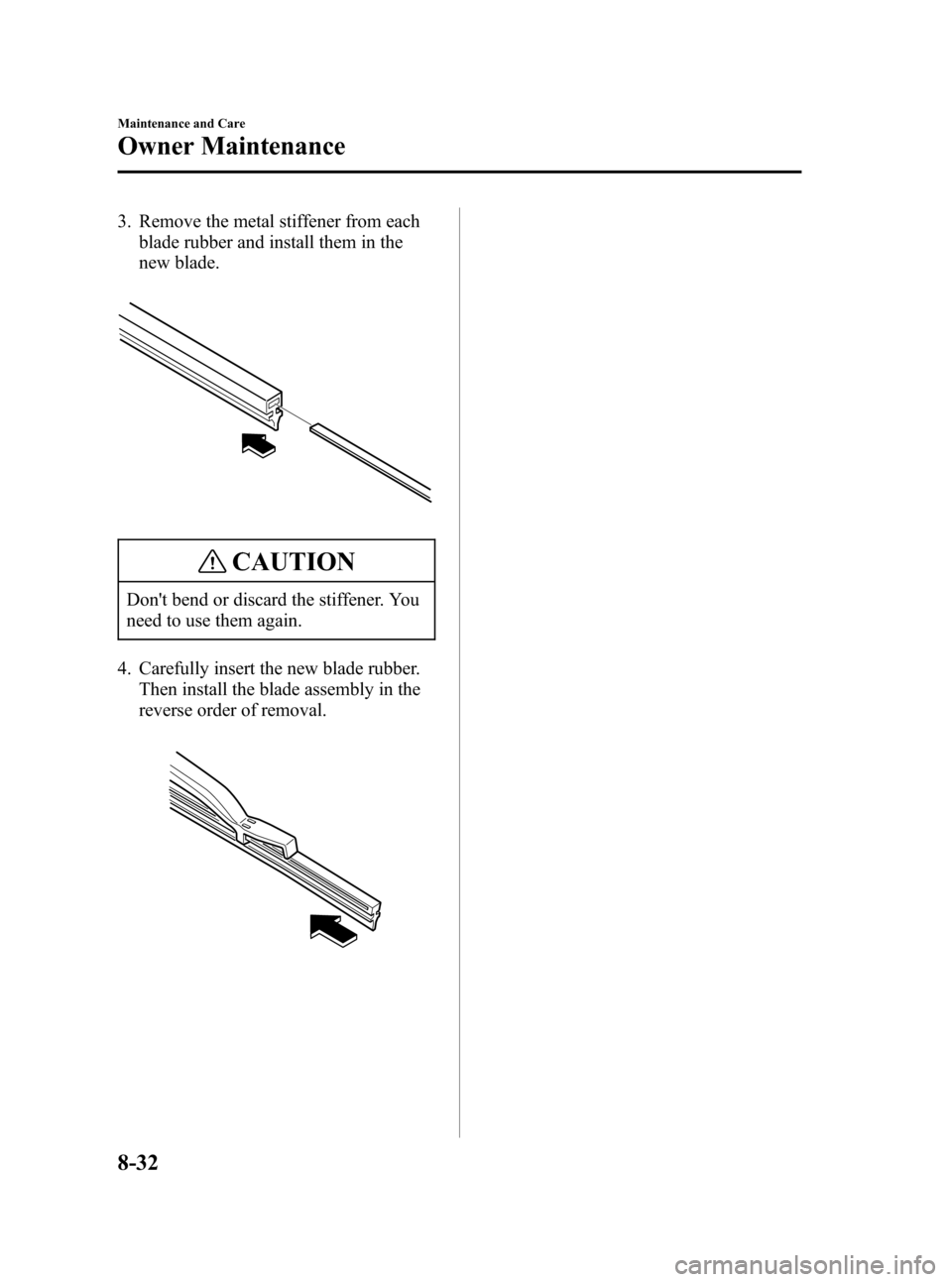
Black plate (306,1)
3. Remove the metal stiffener from each
blade rubber and install them in the
new blade.
CAUTION
Don't bend or discard the stiffener. You
need to use them again.
4. Carefully insert the new blade rubber.
Then install the blade assembly in the
reverse order of removal.
8-32
Maintenance and Care
Owner Maintenance
Mazda3_8V66-EA-06F_Edition3 Page306
Wednesday, August 23 2006 11:21 AM
Form No.8V66-EA-06F
Page 307 of 402
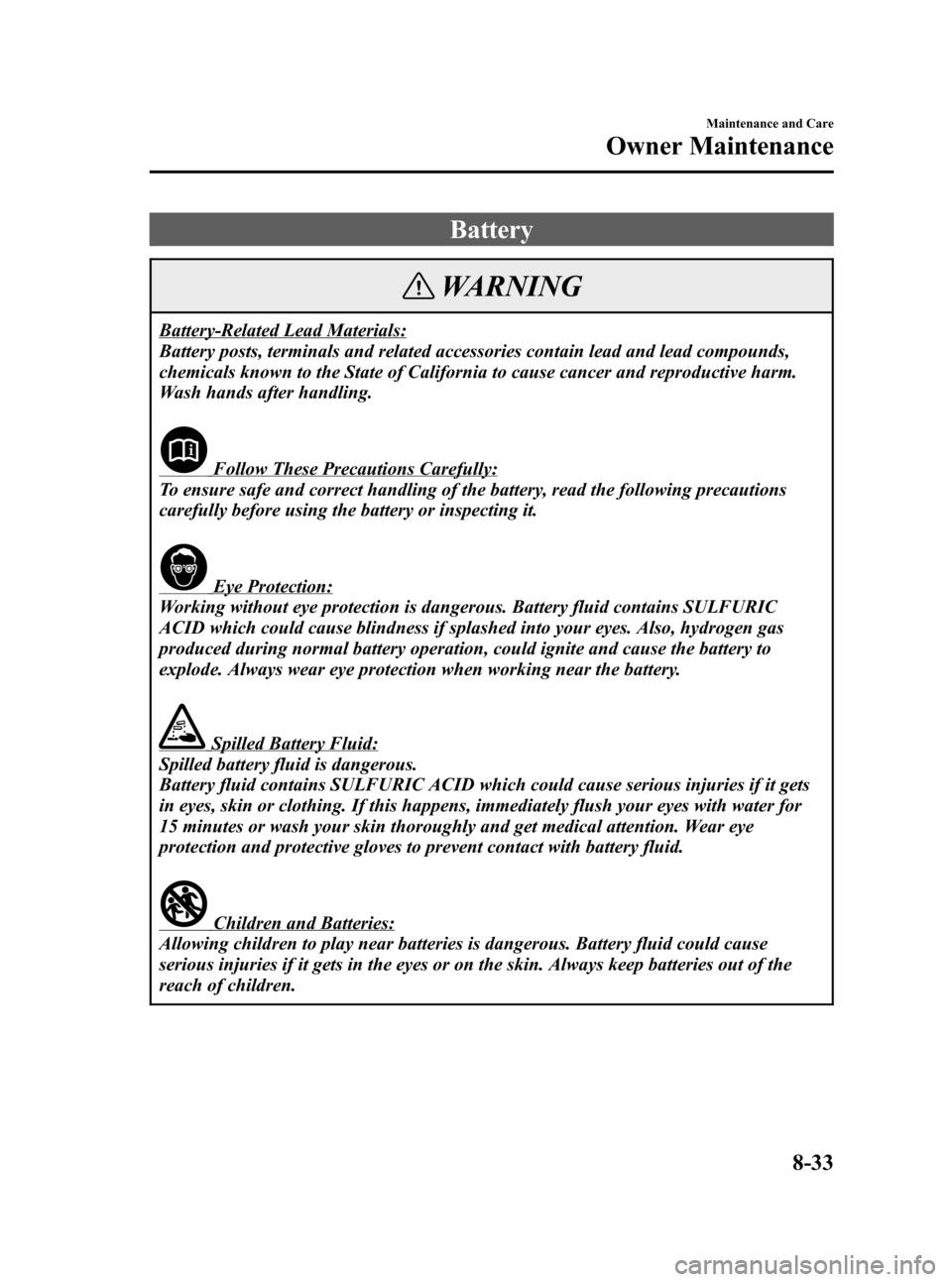
Black plate (307,1)
Battery
WARNING
Battery-Related Lead Materials:
Battery posts, terminals and related accessories contain lead and lead compounds,
chemicals known to the State of California to cause cancer and reproductive harm.
Wash hands after handling.
Follow These Precautions Carefully:
To ensure safe and correct handling of the battery, read the following precautions
carefully before using the battery or inspecting it.
Eye Protection:
Working without eye protection is dangerous. Battery fluid contains SULFURIC
ACID which could cause blindness if splashed into your eyes. Also, hydrogen gas
produced during normal battery operation, could ignite and cause the battery to
explode. Always wear eye protection when working near the battery.
Spilled Battery Fluid:
Spilled battery fluid is dangerous.
Battery fluid contains SULFURIC ACID which could cause serious injuries if it gets
in eyes, skin or clothing. If this happens, immediately flush your eyes with water for
15 minutes or wash your skin thoroughly and get medical attention. Wear eye
protection and protective gloves to prevent contact with battery fluid.
Children and Batteries:
Allowing children to play near batteries is dangerous. Battery fluid could cause
serious injuries if it gets in the eyes or on the skin. Always keep batteries out of the
reach of children.
Maintenance and Care
Owner Maintenance
8-33
Mazda3_8V66-EA-06F_Edition3 Page307
Wednesday, August 23 2006 11:21 AM
Form No.8V66-EA-06F
Page 308 of 402
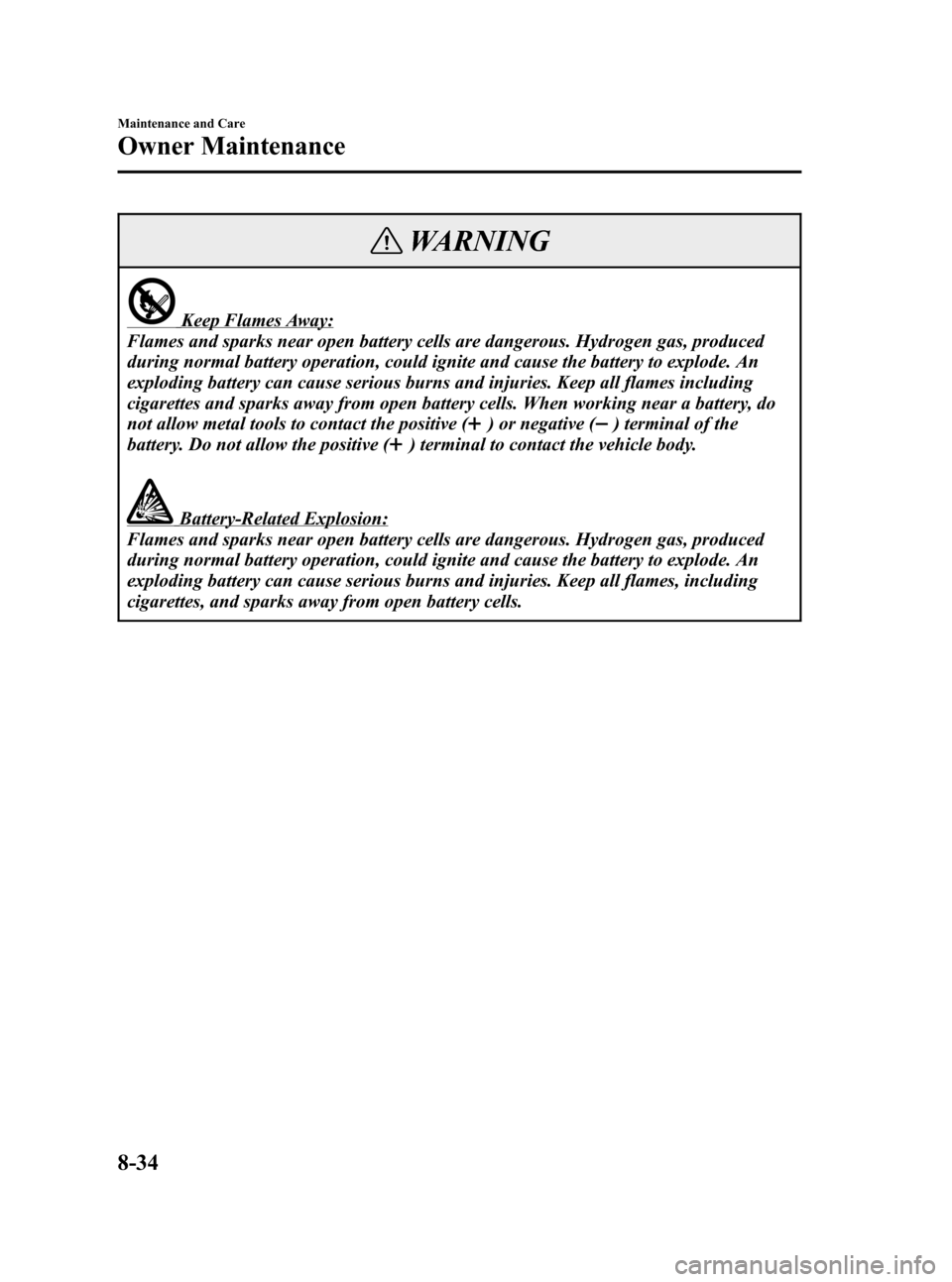
Black plate (308,1)
WARNING
Keep Flames Away:
Flames and sparks near open battery cells are dangerous. Hydrogen gas, produced
during normal battery operation, could ignite and cause the battery to explode. An
exploding battery can cause serious burns and injuries. Keep all flames including
cigarettes and sparks away from open battery cells. When working near a battery, do
not allow metal tools to contact the positive (
) or negative () terminal of the
battery. Do not allow the positive (
) terminal to contact the vehicle body.
Battery-Related Explosion:
Flames and sparks near open battery cells are dangerous. Hydrogen gas, produced
during normal battery operation, could ignite and cause the battery to explode. An
exploding battery can cause serious burns and injuries. Keep all flames, including
cigarettes, and sparks away from open battery cells.
8-34
Maintenance and Care
Owner Maintenance
Mazda3_8V66-EA-06F_Edition3 Page308
Wednesday, August 23 2006 11:21 AM
Form No.8V66-EA-06F
Page 309 of 402
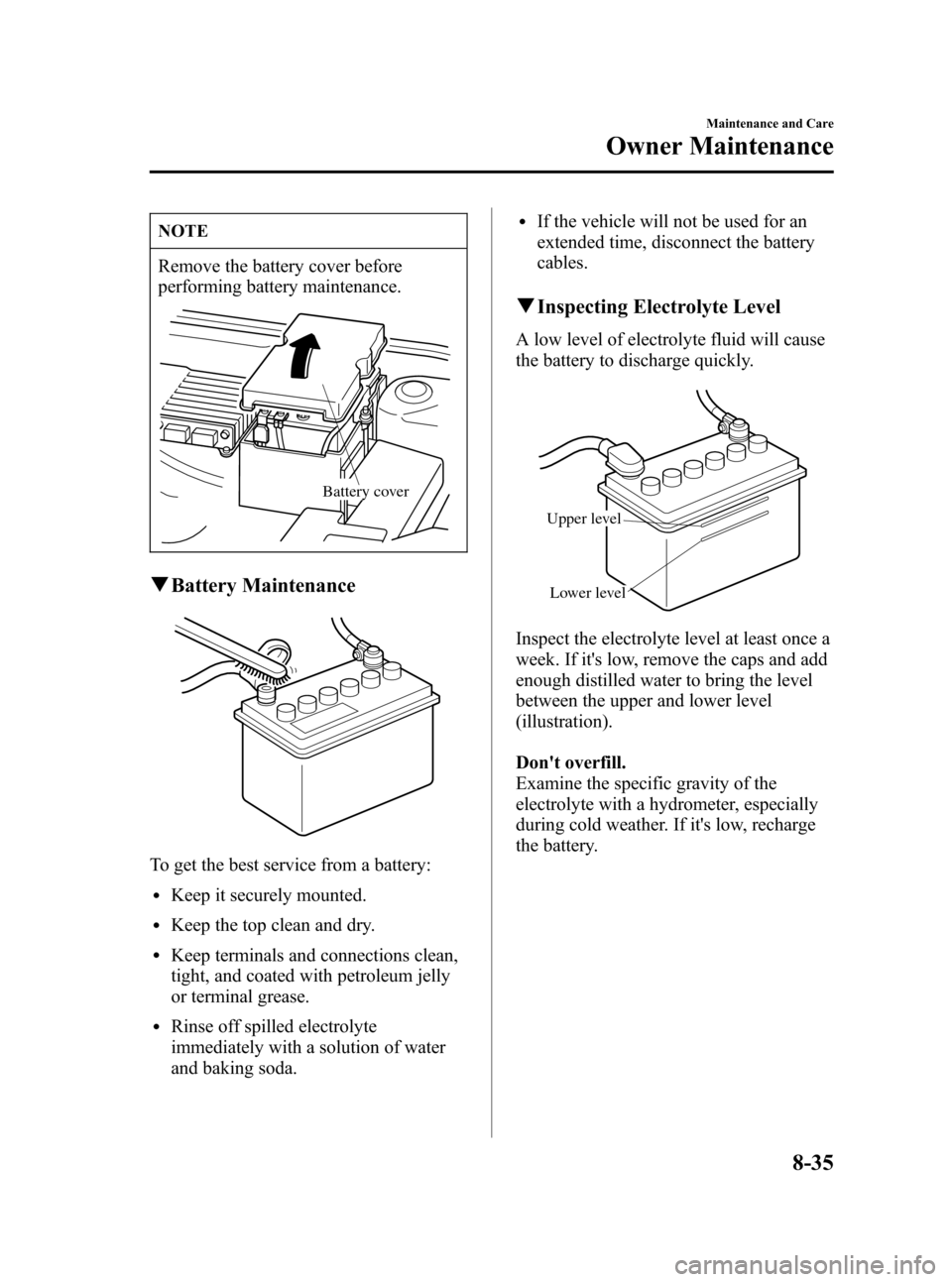
Black plate (309,1)
NOTE
Remove the battery cover before
performing battery maintenance.
Battery cover
qBattery Maintenance
To get the best service from a battery:
lKeep it securely mounted.
lKeep the top clean and dry.
lKeep terminals and connections clean,
tight, and coated with petroleum jelly
or terminal grease.
lRinse off spilled electrolyte
immediately with a solution of water
and baking soda.
lIf the vehicle will not be used for an
extended time, disconnect the battery
cables.
qInspecting Electrolyte Level
A low level of electrolyte fluid will cause
the battery to discharge quickly.
Upper level
Lower level
Inspect the electrolyte level at least once a
week. If it's low, remove the caps and add
enough distilled water to bring the level
between the upper and lower level
(illustration).
Don't overfill.
Examine the specific gravity of the
electrolyte with a hydrometer, especially
during cold weather. If it's low, recharge
the battery.
Maintenance and Care
Owner Maintenance
8-35
Mazda3_8V66-EA-06F_Edition3 Page309
Wednesday, August 23 2006 11:21 AM
Form No.8V66-EA-06F
Page 310 of 402
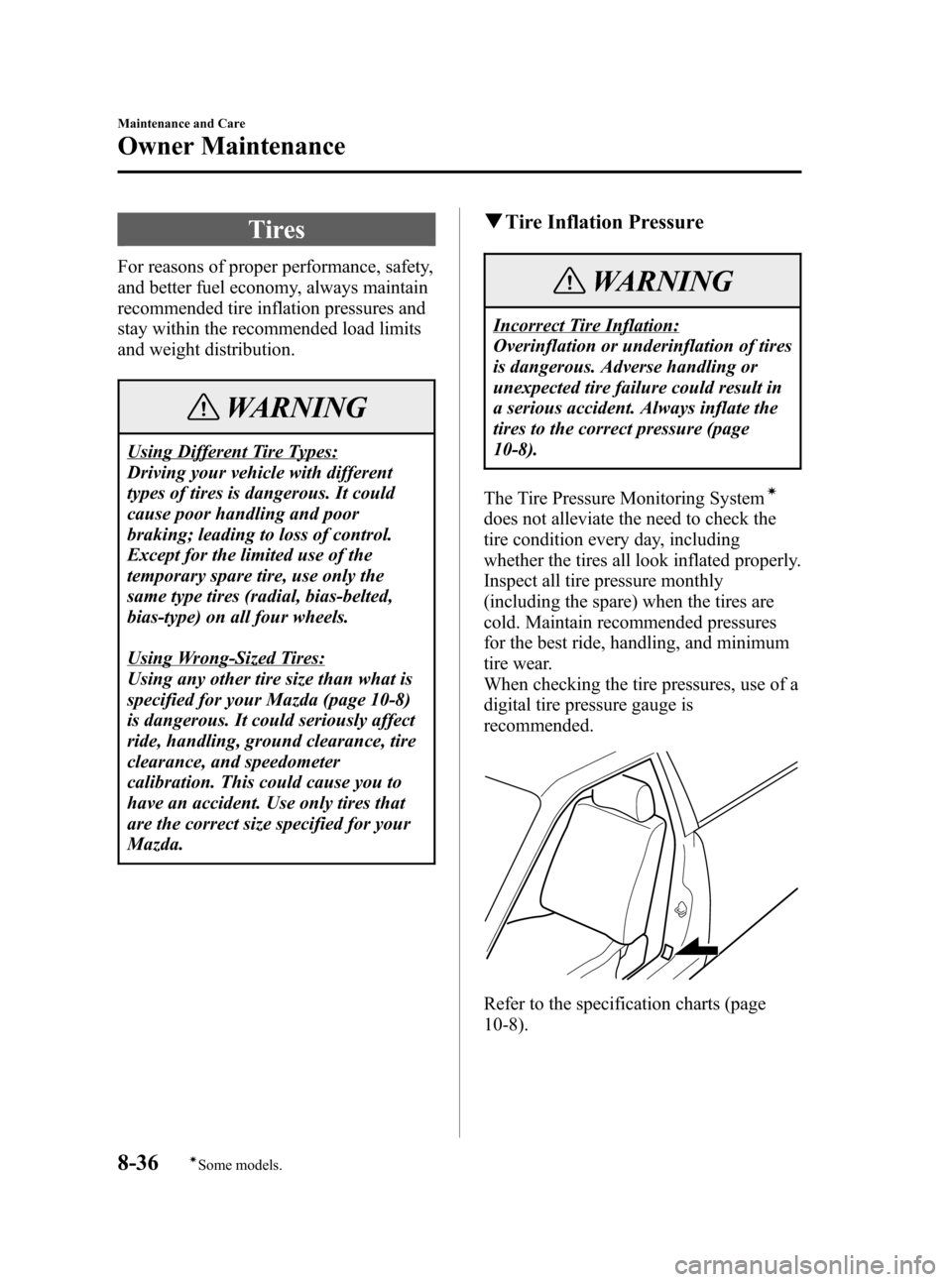
Black plate (310,1)
Tires
For reasons of proper performance, safety,
and better fuel economy, always maintain
recommended tire inflation pressures and
stay within the recommended load limits
and weight distribution.
WARNING
Using Different Tire Types:
Driving your vehicle with different
types of tires is dangerous. It could
cause poor handling and poor
braking; leading to loss of control.
Except for the limited use of the
temporary spare tire, use only the
same type tires (radial, bias-belted,
bias-type) on all four wheels.
Using Wrong-Sized Tires:
Using any other tire size than what is
specified for your Mazda (page 10-8)
is dangerous. It could seriously affect
ride, handling, ground clearance, tire
clearance, and speedometer
calibration. This could cause you to
have an accident. Use only tires that
are the correct size specified for your
Mazda.
qTire Inflation Pressure
WARNING
Incorrect Tire Inflation:
Overinflation or underinflation of tires
is dangerous. Adverse handling or
unexpected tire failure could result in
a serious accident. Always inflate the
tires to the correct pressure (page
10-8).
The Tire Pressure Monitoring System
í
does not alleviate the need to check the
tire condition every day, including
whether the tires all look inflated properly.
Inspect all tire pressure monthly
(including the spare) when the tires are
cold. Maintain recommended pressures
for the best ride, handling, and minimum
tire wear.
When checking the tire pressures, use of a
digital tire pressure gauge is
recommended.
Refer to the specification charts (page
10-8).
8-36
Maintenance and Care
íSome models.
Owner Maintenance
Mazda3_8V66-EA-06F_Edition3 Page310
Wednesday, August 23 2006 11:21 AM
Form No.8V66-EA-06F